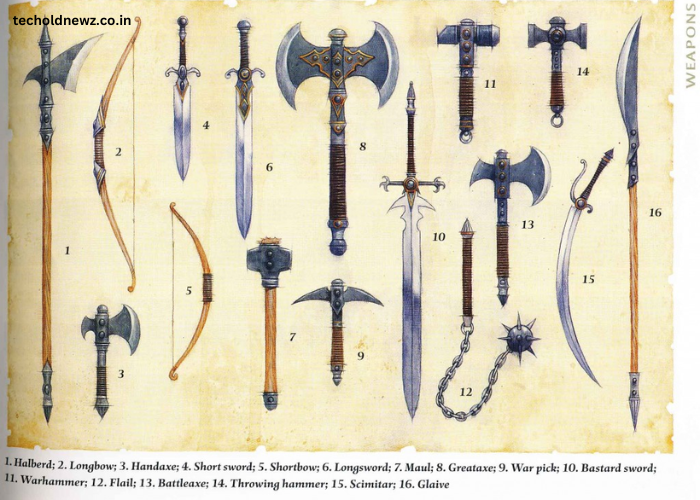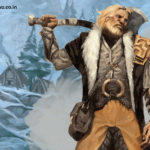Weapons are one of the most important aspects of any character’s arsenal in Dungeons & Dragons 5th Edition (5e). Whether you’re a sword-wielding fighter, a bow-shooting ranger, or a barbarian who prefers to smash enemies with a great axe, choosing the right weapon can define your combat style and effectiveness in the game. The vast selection of weapons available in 5e can be overwhelming, but understanding the different types and their benefits is key to maximizing your character’s potential.
In this blog post, we’ll break down the different types of 5e weapons, provide detailed insights into their pros and cons, and offer tips for selecting the best weapons for your character’s build.
Key Points:
- 5e weapons come in various categories like simple, martial, ranged, and finesse.
- Each weapon type offers unique features that cater to different playstyles.
- Understanding weapon properties like range, damage, and special features can help you make the best choice.
What Are the Different Types of 5e Weapons?
In 5e, weapons are divided into categories based on their ease of use, power, and specific features. The two primary categories of weapons are Simple and Martial, with additional distinctions between ranged and melee weapons.
Simple Weapons
Simple weapons are easier to use and typically require less proficiency than martial weapons. These weapons are ideal for new players or characters who don’t have extensive combat training. Examples of simple weapons include daggers, clubs, and shortswords. These weapons usually have lower damage output compared to martial weapons, but they are perfect for characters who need an accessible weapon option.
Examples of Simple Weapons:
- Club: Deals 1d4 bludgeoning damage and has the Light property, meaning you can use it for two-weapon fighting.
- Dagger: Deals 1d4 piercing damage and can be thrown, offering both ranged and melee combat options.
- Shortsword: Deals 1d6 piercing damage and has the Finesse property, allowing you to use Dexterity instead of Strength for attack rolls.
Martial Weapons
Martial weapons are the heavy hitters of Dungeons & Dragons 5e. They generally deal more damage than simple weapons and require more proficiency to use effectively. Characters with martial proficiency can wield these weapons to maximize their combat potential. Some martial weapons, like greatswords or longbows, deal significant damage but may have restrictions like range or weight.
Examples of Martial Weapons:
- Longsword: Deals 1d8 slashing damage and can be wielded with one or two hands, making it versatile.
- Greatsword: Deals 2d6 slashing damage and has the two-handed property, meaning it requires both hands to wield but deals high damage.
- Longbow: Deals 1d8 piercing damage and has the Range property, allowing for long-range combat, making it ideal for rangers or archers.
What Are the Key Properties of 5e Weapons?
Understanding the different properties of weapons in Dungeons & Dragons 5e can help players make informed decisions when choosing the best weapons for their characters. Here are some key properties of weapons in 5e:
Damage Type
Each weapon deals a specific type of damage: bludgeoning, piercing, or slashing. The type of damage can be important because certain creatures or enemies have resistances or vulnerabilities to specific types of damage. For example, a creature might have resistance to slashing damage but vulnerability to piercing damage.
Range
Weapons also vary in their range capabilities. Melee weapons are used in close combat and typically have a range of 5 feet, while ranged weapons like longbows or crossbows allow characters to attack from a distance. For ranged weapons, the range is often expressed in two numbers: normal range and long range. For example, a longbow has a normal range of 150 feet and a long range of 600 feet.
Special Features
Some weapons come with special features that can enhance combat. For example, a finesse weapon, like a rapier, allows you to use your Dexterity modifier for attack rolls instead of Strength. Weapons with the heavy property require more strength to wield effectively and may impose disadvantage on attack rolls for small creatures.
Weapon Properties Table:
| Weapon Type | Damage | Range | Special Features |
|---|---|---|---|
| Club | 1d4 Bludgeoning | 5 ft (Melee) | Light |
| Longsword | 1d8 Slashing | 5 ft (Melee) | Versatile (1d10) |
| Greatsword | 2d6 Slashing | 5 ft (Melee) | Two-Handed |
| Longbow | 1d8 Piercing | 150 ft (Normal) | Ammunition, Range (600 ft Long) |
How Do 5e Weapons Compare in Terms of Damage?
The damage a weapon deals is one of the most important factors when choosing your weapon. In 5e, weapons are designed to deal damage in a variety of ways, from smaller, more frequent hits to larger, more powerful blows. Let’s compare the damage of a few commonly used weapons.
- Dagger: A dagger is a simple weapon that deals 1d4 damage, making it less powerful than some of the heavier options, but it can be thrown and has the Light property, allowing for two-weapon fighting.
- Longsword: A versatile martial weapon that deals 1d8 damage (or 1d10 when wielded with two hands). It’s great for both offensive and defensive players who want a reliable weapon with decent damage output.
- Greatsword: This weapon deals 2d6 damage, making it one of the highest-damaging weapons available for martial characters. However, it requires two hands to wield, which means you lose the ability to wield a shield.
Damage Comparison Chart:
| Weapon | Damage | Notes |
|---|---|---|
| Dagger | 1d4 | Light, can be thrown |
| Longsword | 1d8 | Versatile (1d10 with two hands) |
| Greatsword | 2d6 | Two-handed, highest damage |
How Do You Choose the Best Weapon for Your Character?
Choosing the best weapon for your Dungeons & Dragons character depends on your class, combat style, and what role you want to fulfill in your party. For example, if you’re playing a rogue, you might prefer a rapier, a finesse weapon that allows you to deal more damage with Dexterity. If you’re playing a fighter, a longsword or greatsword might be better, as these weapons can deal consistent damage while giving you flexibility in combat.
Class Considerations:
- Fighters and Barbarians: These classes excel with martial weapons like greatswords or longswords. They can take full advantage of these weapons’ damage output.
- Rogues: Rogues benefit from finesse weapons like the rapier, which allows them to use Dexterity for attacks and critical hits.
- Rangers: Rangers often choose ranged weapons like the longbow or shortbow, capitalizing on their ranged combat expertise.
Conclusion: Choosing the Right 5e Weapon
Weapons play a crucial role in your character’s success in Dungeons & Dragons 5e. Whether you prefer close-range combat or long-range precision, there’s a weapon that fits your playstyle. By understanding the different types of weapons, their properties, and how they interact with your class abilities, you can ensure your character is always armed with the best tool for the job.
Remember to consider your class, the type of damage you need, and your character’s abilities when selecting a weapon. The right choice can make a huge difference in your ability to defeat enemies and protect your allies.
FAQ’s
1. What is the best weapon for a Fighter in 5e?
A longsword or greatsword is ideal for a Fighter in 5e, depending on whether you prefer versatility or higher damage output. A longsword is versatile, while a greatsword offers heavy damage.
2. Can you dual-wield weapons in 5e?
Yes, you can dual-wield in 5e using weapons with the Light property, such as a dagger or shortsword. You can make an off-hand attack without adding your Dexterity modifier to the damage.
3. What does the Finesse property do?
Weapons with the Finesse property, like a rapier, allow you to use your Dexterity modifier instead of Strength for attack rolls. This is useful for characters who have high Dexterity but low Strength.
4. What are the differences between Simple and Martial Weapons?
Simple weapons are easier to use and require less proficiency, while martial weapons are more powerful but require higher proficiency and are typically suited for more experienced characters.
5. Can a Wizard use a weapon in 5e?
Yes, Wizards can use weapons, but they typically rely on their spells for combat. Common weapons for Wizards include daggers and quarterstaffs, which can serve as backup weapons.


